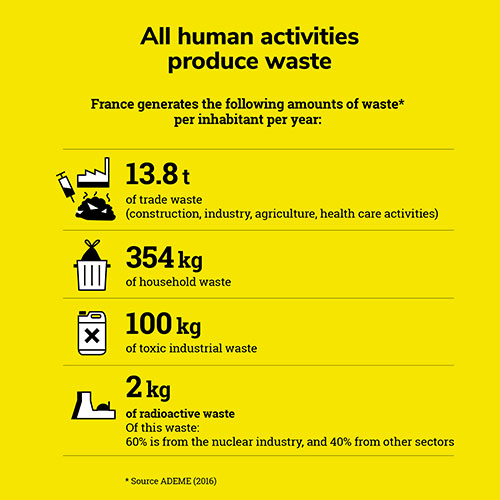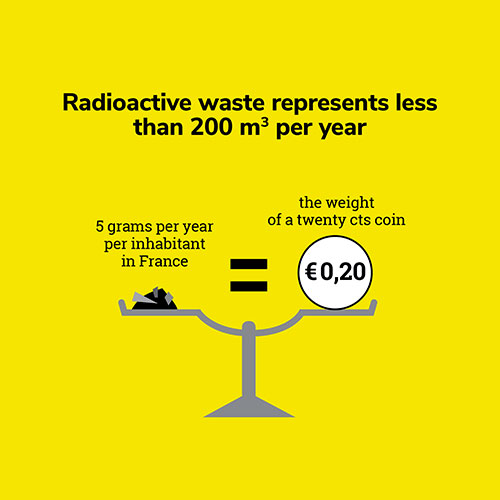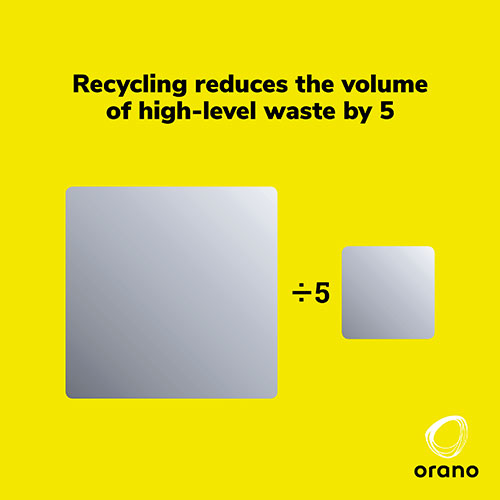
All about radioactive waste in France

What is waste ?
We use the term waste when something has no possible further uses. This contrasts with recoverable material, which can be recycled and reused.

Radioactive waste comes from various sectors
- Nuclear power industry Civil nuclear power plants, plants manufacturing fuel assemblies, dismantling, etc.
- Non-nuclear power industry Extraction of rare earth metals, manufacture of sealed sources, weld inspections, sterilization of medical materials, conservation of food products, dating and restoration of artworks, etc.
- Research In the fields of civil nuclear energy, medicine, nuclear and particle physics, agronomy, chemistry, biology, etc.
- Defense Deterrent force, including nuclear propulsion in the navy, army, etc.
- Medecine Diagnostic and therapeutic activities, scintigraphy, radiotherapy, etc.
There are nearly 1,200 producers of radioactive waste in France
Types of radioactives waste
Out of the 2 kg of radioactive waste produced in France, per inhabitant per year:
- 1.8 kg is radioactive waste described as “short-lived”(1)
- 200 grams is “long-lived” waste(2)
(2)“Long-lived”: the radioactivity of this waste decreases by half in more than 30 years. They can therefore remain radioactive for several tens of thousands of years. This waste comes in particular from spent fuel after use in nuclear power plants. It undergoes treatment and recycling to reduce its volume and toxicity.

Solutions exist for all types of radioactives waste in France
- A long-term disposal solution in a surface facility is available for 90% of radioactive waste.
- The 10% represented by long-lived waste is stored safely pending the availability of a disposal facility, in accordance with the French laws of 1991 and 2006.(3)
(3)Responsibility for monitoring and implementing the law has been given to the French Parliamentary Office for the Evaluation of Scientific and Technological Choices (Office Parlementaire d'Évaluation des Choix Scientifiques et Technologiques – OPECST)
Orano : 60 years of high-tech industrial experience
Undestanding the waste conditioning and disposal value chain
- Following recycling operations, 96% of spent nuclear fuel (95% uranium + 1% plutonium) can be reused to manufacture new fuel, which will then supply more electricity in turn.
- High-level radioactive waste (4%) is vitrified, then conditioned in stainless steel canisters and stored at the La Hague site, pending disposal. This conditioning is certified by 10 safety authorities worldwide. It allows high-level waste to be managed in optimum safety conditions over the very long term, during both the storage and future underground disposal periods. As a result of these operations, the volume was divided by 5 and the long-term toxicity by 10.
- The metal structures from fuel assemblies (long-lived intermediate-level waste) are compacted and conditioned in steel drums. They are also stored pending disposal.
- The foreign waste from spent fuel that is processed at Orano La Hague is returned to its country of origin.
- Waste from fuel cycle operations is conditioned using various technologies, mainly homogenous cement encapsulation or encapsulation by injection, placed in metal containers or concrete shells, then stored or sent to existing surface disposal centers. Orano is constantly developing and optimizing its waste conditioning solutions in order to reduce volumes and conditioning inertia.

Storage of high-level waste: the CIGEO solution
Andra (the French National Agency for Radioactive Waste Management – Agence Nationale pour la gestion des Déchets Radioactifs), is responsible for managing existing disposal centers and conducting studies on geological disposal for high-level and long-lived intermediate-level waste, namely the CIGEO project, a research laboratory at Bure-Saudron (Meuse/Haute-Marne).The project represents less than 2% of the cost of producing electricity using nuclear power in France.
Orano would like to see CIGEO enter operation as soon as possible in order to implement the most responsible solution in the long term with regard to future generations. Geological disposal represents the most sustainable and safest solution for 80% of final waste. Today, this waste is safely stored pending the commissioning of CIGEO.
Its long-term safety has been demonstrated scientifically and the confinement performance of clay is well-established. Safety is also assured by the way in which this waste is conditioned. For example, the vitrification process makes it possible to encapsulate the final waste residues (fission products from processing/recycling operations) in a glass matrix with extremely stable chemical properties, guaranteeing the confinement of vitrified materials over the very long term. Ten safety authorities worldwide certify this packaging process.
National Plan for the Management of Radioactive Materials and Waste
The National Public Debate Commission (Commission nationale du débat public – CNDP) organized a public debate in the second half of 2018 in order to prepare for the 5th National Plan for the Management of Radioactive Materials and Waste (Plan National de Gestion des Matières et Déchets Radioactifs – PNGMDR) for 2019-2021. Updated every three years, the PNGMDR is a document that assesses existing methods of managing radioactive waste and materials, identifies foreseeable storage and disposal facility requirements and indicates the capacities needed for those facilities and the duration of storage. Orano welcomes the launch of this public debate, the first to be held as part of the revision of the PNGMDR. It is an opportunity to explain the main issues regarding nuclear waste to the general public, and respond to any questions or concerns raised. It is also a chance to recall that companies in the nuclear sector now know how to condition nuclear waste and improve existing management solutions in order to reduce volumes and recover materials. This covers waste with known properties that has already been disposed of in centers intended for this purpose, or safely stored pending a definitive solution.
- Nuclear waste The nuclear industry manages its conventional and radioactive waste using very rigorous, very carefully controlled methods. Orano has been transforming and recycling nuclear materials for over 50 years.
- Recycling: a strategic asset for the nuclear industry Thanks to Orano’s unique technologies, 96% of used nuclear fuel is recycled. For more than 50 years, at its La Hague and Melox plants, the group has been processing recoverable materials and fabricating new MOX fuels.
- Everything you need to know about France's National plan for the management of radioactive materials and waste Updated every three years, the PNGMDR is a document that assesses existing methods of managing radioactive waste and materials, identifies foreseeable requirements.